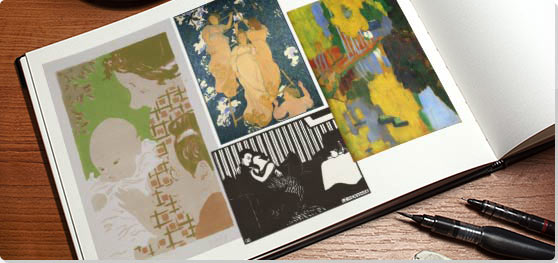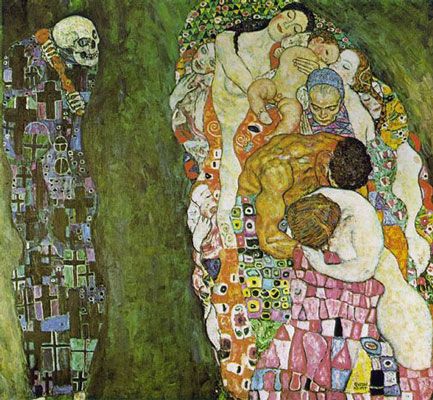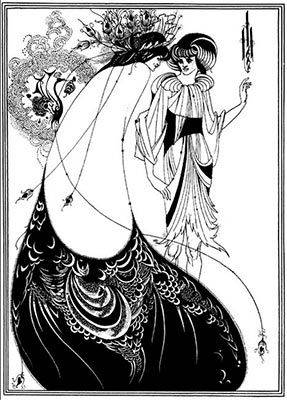Summary of Les Nabis
The Nabis (from the Hebrew and Arabic term for "prophets,") were a Symbolist, cult-like group founded by Paul Sérusier, who organized his friends into a secret society. Wanting to be in touch with a higher power, this group felt that the artist could serve as a "high priest" and "seer" with the power to reveal the invisible. The Nabis felt that as artists they were creators of a subjective art that was deeply rooted in the soul of the artist. While the works of the Nabis differed in subject matter from one another, they all ascribed to certain formal tenets - for example, the idea that a painting was a harmonious grouping of lines and colors. This one idea, however, produced many different solutions. The subjectivity and what might be called the artist's personal style was, in fact, accomplished through the choice of how to arrange these lines and colors. As an example of the Nabi approach, at the beginning of their meetings, they would recite the following "mantra" together: "sounds, colors, and words have a miraculously expressive power beyond all representation and even beyond the literal meaning of the words."
Key Ideas & Accomplishments
- The Nabi group grew out of the work of Paul Gauguin, literary theory, and Symbolism - specifically, the idea that color and shape could represent experience - that, as the Nabi historian Charles Chassé has said, "a picture had meaning only when it possessed 'style.' That is to say when the artist had succeeded in changing the shape of the objects he was looking at and imposing on them contours or a color that expressed his own personality."
- The Nabi artists considered themselves to be the initiates of a brotherhood devoted to exploring the pure sources of art, personal or spiritual. Searching for beauty beyond that found in nature, they seized upon the mysterious and mystical even if the subject related to ordinary, everyday life.
- The Nabis expanded their aesthetic into the area of applied arts as well, including architectural painting, decorative screens, murals, posters, book illustrations, and designs for the theater. This interest in the decorative was both a part of the 19th century's retreat into aesthetics and beauty and of the ensuing century's taste for abstraction and the age of advertising.
Artworks and Artists of Les Nabis
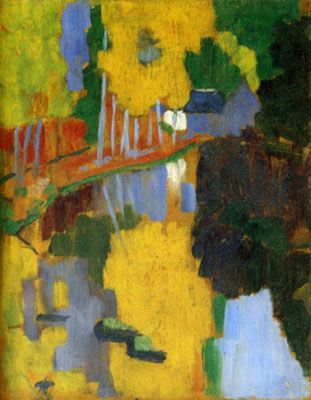
The Talisman, the River Aven at the Bois d'Amour
Painted on the lid of a cigar box, this work was painted under Paul Gauguin's direction in his Synthetist style of expressive color. Gauguin had encouraged Paul Sérusier to approach nature from a subjective point of view, instructing the artist to use colors straight from the tube rather than attempting to mix them and match them up to what he saw in nature. According to Maurice Denis, Gauguin had told Sérusier: "How do you see these trees? They are yellow. So, put in yellow; this shadow, rather blue, paint it with pure ultramarine; these red leaves? Put in vermilion." Yet, the painting is also different from the work of Gauguin. The result was far more abstract - a painted reality, the "equivalent" of that which is perceived by the artist - with flat areas of bold color. However, certain elements of the landscape remain recognizable: trees, the path, the riverbank, and the mill. On his return to Paris, Sérusier showed his young fellow painters, the future Nabis, what was to become their "Talisman": the "magical charm" for the group. The theorist of the Nabi group, Denis, explained that in front of this landscape, he and his friends felt "liberated from all the yokes that the idea of copying brought to [our] painters' instincts."
Oil on board - Musée d'Orsay, Paris
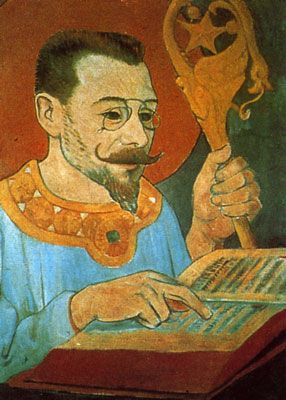
Paul Ranson in Nabi Costume
We know of very few portraits by Paul Sérusier, who specialized more in producing scenes of rural life in the Synthetist style of Paul Gauguin. The subject of the portrait, Paul Ranson, was a member of the Nabi group from the time it was set up by Sérusier in 1888, and is portrayed here in what seems to be a ceremonial costume. Recognizable by his goatee and lorgnon, he is depicted as deciphering the mysterious characters of a large manuscript. This is a clear example of the esotericism favored by certain Nabis, including Sérusier and Ranson. Moreover, the group used to meet in Ranson's studio in the Boulevarde du Montparnasse each Saturday. The studio was nicknamed "The Temple." There is no evidence that the Nabis actually wore this sort of garment; indeed, it is important to bear in mind that the Nabis' meetings at the "Temple" could also be lighthearted and farcical. However, the various symbols on Ranson's costume reveal Sérusier's interest in the occult. These include a five-pointed star decorating the crosier. This "pentogram," for example, could represent the mind or the head dominating the four limbs. Sérusier's painting, therefore, serves as a sort of document of the Nabis group in that it suggests the group's practices in a symbolic way.
Oil on canvas - Musée d'Orsay, Paris

Nabi Landscape
This simple composition is based on flat shapes - including the flat, exotic patterns of Paul Gauguin - intense colors, and curving lines based on organic form. However, the subjects are Symbolist in character, and include the astral symbols of sun and moon hovering in the sky above the mountains (the celestial home of the gods), a bearded prophet figure or "Nabi" encased in a dark aura, (whom some have suggested represents the Hindu god Rama) wearing an ouroboros bracelet (the snake biting its tail), a peacock, and a phoenix-like bird - all symbols of the cyclical and eternal life - mounted by a female figure (possibly Sita, wife of Rama, coming back to earth). On the back of the painting are Arabic letters that spell out "Nabi." In this painting, Ranson reveals himself as the Nabi artist closest to the style of Art Nouveau, and the artist perhaps most seriously wedded to the kinds of obscure iconography taken from world religions, Celtic legends, and theosophy (a system of esoteric philosophy seeking direct knowledge of the mysteries of being and nature, particularly the nature of the divine).
Oil on canvas - Private Collection
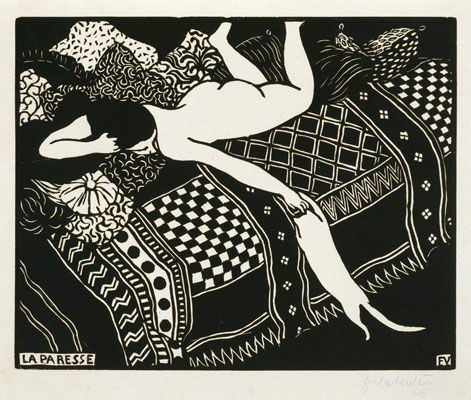
L'Indolence (Laziness)
Félix Vallotton's woodcut style was novel in its starkly reductive opposition of large masses of undifferentiated black and areas of unmodulated white. Vallotton emphasized outline and flat patterns, and generally eliminated the gradations of traditional modeling. In this work he was especially influenced by the Japanese woodcut; in fact, a large exhibition of these prints had been shown at the École des Beaux-Arts in 1890, and Vallotton, like many artists of his era, admired and collected them.
As in this example, the figure is not individualized, but serves as an image of an idea - indolence. The mood is quiet and the overall effect somewhat decorative, but executed with an economy of means. To the Nabi group Valloton contributed his work in the form of the modern woodcut. The many woodcuts he produced during the 1890s were recognized as innovative, and established him as a leader in the revival of true woodcut as an artistic medium rather than as a mere means of reproducing a drawn or painted work. Vallotton's woodcuts were widely disseminated in periodicals and books in Europe as well as in the United States, and have been suggested as a significant influence on the graphic art of Edvard Munch, Aubrey Beardsley, and Ernst Ludwig Kirchner.
Woodcut on paper - Museum of Fine Arts, Houston
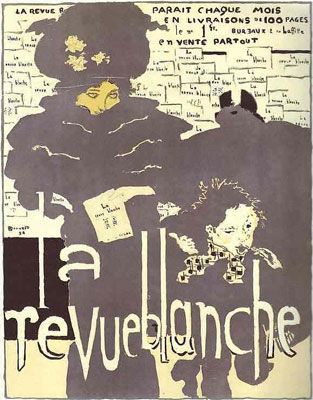
La Revue Blanche
La Revue blanche, a journal of politically, artistically, and socially progressive ideas was founded by the Natanson brothers in 1889, and named after its white cover. The journal published the works of the most innovative writers and artists of the period, including Pierre Bonnard himself. Misia Godebska, the wife of Thadee Natanson, was possibly the model for the female figure in this poster and emblematic of the elegant Parisian reader of La Revue blanche.
Her silhouette dominates at the left, but is balanced by the abstract silhouette of the gentleman perusing periodicals in the background and the urchin-like figure of a boy in the right foreground. The stylish Parisienne holds a copy of La Revue blanche in one hand, as the boy gestures towards it with his thumb. Bonnard was particularly influenced by the Japanese color woodblock prints that had begun appearing in Europe in the late-19th century. He saw that their bold, asymmetrical, flat shapes could be adapted to the needs of poster design, which in the interest of advertising, had to be clearly "readable," yet "with the times." Also in the interest of advertising, lettering was a significant component and an integral part of the design - parts of the letters are even woven into the dress of the female figure.
Bonnard was the most gifted and productive graphic artist in the group of Nabi artists. Like other members of the Nabis, he believed in what he later called ''popular production.'' It is in such graphic works as this poster that Bonnard's avant-garde design concepts were made accessible to the public that was just being introduced to the new age of advertising.
Lithograph - Private Collection
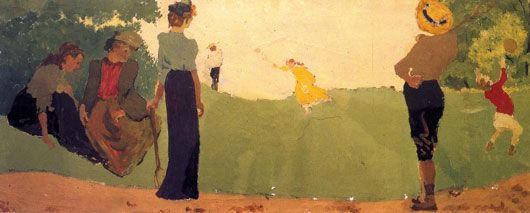
Game of Shuttlecock
This lateral, frieze-like composition was part of a six-paneled work that was Vuillard's first decorative painting for a private residence. In 1892, Thadee Natanson's cousin Stephane persuaded his sister Leonie and her moneyed industrialist husband Paul Desmarais to commission this piece, perhaps as a means for Paul Desmarais to establish himself as a person of culture. This panel reveals how leisure activities were available to the upper classes at the time, and, in particular, demonstrates the freedom that the New Woman found in sports, which is reflected in the contemporary fashion that clothes Vuillard's figures. Gloria Groom has pointed to the female in the center left foreground, whose slim skirt line has added fullness at the lower back edge, alluding to the transition in fashion from the flounced bustle of the 1880s to the inverted lily shape skirts with the tailored jackets of the 1890s that allowed females to participate in sports. Her partner wears knickerbockers associated with cycling. Two domestics or chaperones appear at the left in their Sunday best, even if they do not have access to the same leisure activities as the upper crust. The roughened forms of all the figures almost seem to poke fun at the entire sport enterprise.
Vuillard, perhaps the least conventional Nabi at this time in terms of his grayed-down palette and coarse shapes, also contributed to the group a certain appreciation for the motifs of contemporary life, reflecting differences amongst the social classes.
Oil on canvas - Desmarais Collection, Paris
Beginnings of Les Nabis
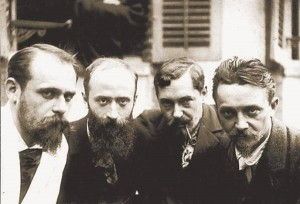
When in the summer of 1888, Sérusier first visited Pont-Aven, he at reluctantly (thinking Gauguin too avant-garde) agreed to meet Gauguin through the artist Émile Bernard. Together they visited a beautiful natural area called the Bois d'Amour where, under the direct guidance of Gauguin and his Synthetist technique, Sérusier painted the work that he brought back to Paris and named The Talisman (1888). He thereupon decided to preach this new style to his own group of friends. Around the same time, Sérusier was also influenced by the current ideas circulating amongst the Symbolists including Neoplatonic philosophy, which combined pagan and Christian thought, and other spiritual directions.
Sérusier the theorist then organized his friends into a secret society - the Nabis. On Saturdays, the group met at the home of Paul Ranson - who served as the social "glue" that helped keep the group together - where they were treated to puppet shows and given nicknames by Ranson. The group also included Maurice Denis, Félix Vallotton, Pierre Bonnard, Édouard Vuillard, Vuillard's brother-in-law Ker-Xavier Roussel, Georges Lacombe, and Aristide Maillol. The group published their work in the progressive journal founded by the Natanson brothers, La Revue Blanche, from 1891 to 1900.
Les Nabis: Concepts, Styles, and Trends
Nabi Diversity
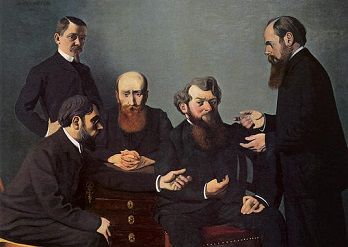
Amongst the other most noted Nabis, Sérusier and his friend Ranson were the more serious, mystical, philosophical, and Neo-Catholic amongst the group, reviving sacred art and studying theosophy. Ranson's work bears the closest resemblance of all the Nabis to the decorative and organic style of Art Nouveau. The Swiss artist and anarchist Vallotton created portraits of many Symbolist writers and in the last decade of the 19th century executed many wood engravings of high quality, following in the footsteps of Gauguin's use of the medium. Roussel, also an anarchist, was unusual in choosing mythological subjects, combining the 18th-century Rococo style of Jean-Honoré Fragonard with the interests of the fin-de-siecle - a kind of "drawing-room paganism," as it has been called.
Japonism and The Nabis
Japonism describes the influence of Japanese art, especially Ukiyo-e prints (literally, pictures of the floating [or everyday] world), on French artists in the second half of the 19th century. These prints were first exhibited in the Japan Pavilion at the 1867 Paris World's Fair, but also later at the École des Beaux-Arts in 1890. The term Japonism was coined in 1872 by the French art critic Phillippe Burty to describe the influence of Japanese decorative objects as well as woodcuts on European art. Usually, the term is applied to the work of the Impressionists and Post-Impressionists, who were specifically influenced by the flat blocks of color, the emphasis on design, and the simple, everyday subject matter. However, the woodcuts of Vallotton also demonstrate this influence with their flat shapes and asymmetrical design, as do many of the works of Bonnard and Vuillard, who painted scenes of everyday life taken from unusual points of view.
The Symbolism of Maurice Denis
Denis wrote several articles that outlined Nabi ideas. He perceived Symbolism in general and its rejection of Naturalism and its tendency to abstraction as a means to a new spirituality. For him, the feeling of the work of art derived from the "state of the artist's soul." Meaning does not originate in the subject matter, but in the painting itself, from the forms and colors. Denis is famous for having made one of the key statements that was seized upon by modernist painters of the 20th century: "A picture - before being a war horse, a female nude, or some anecdote - is essentially a flat surface covered with colors in a particular order." He added that "... every work of art is a transposition, a caricature, the passionate equivalent of a received sensation." This theory of "equivalents" helped distinguish the Nabi work from that of Gauguin. Denis acknowledged having learned the rudiments from Gauguin, but suggested substituting his "over-simplified idea of pure colors" with a variety of color harmonies as in nature, adapting all the "resources of the palette to all the states of our sensibility." He favored the subjective viewpoint in the face of reality, seeking "equivalents in beauty." A devout Roman Catholic, Denis often painted Biblical subjects in modern settings as well as decorative murals.
The Intimism of Bonnard and Vuillard
The two most significant Nabi artists were Bonnard and Vuillard, who, as friends, shared a studio at the foot of Monmartre. They were both enthusiastic readers of the French symbolist poet Stephane Mallarme. Bonnard executed a number of graphic works including the 1895 cover for La Revue Blanche and a number of book illustrations. He ascribed to the Nabi doctrine of abandoning three-dimensional modeling in favor of flat areas of color, but did not adhere to the Symbolist subjects seized upon by others of the group. Vuillard's Au Lit (1891), evenly painted in flat areas, shows the influence of Denis's ideas. However, he is more known for his interior scenes, creating a system of value tones and surface patterns.
In truth, Bonnard and Vuillard were more interested in the fashionable Symbolist milieu - where all the talk about neo-platonism and Mallarme took place - as well as the fashionable women who were in attendance. Vuillard, for example, became a kind of "court painter" to Misia Sert, who had been the wife of Thadee Natanson, editor of La Revue Blanche. Bonnard's and Vuillard's work has frequently been describe as "intimist"; They preferred to paint the contemporary and daily life around them rather than remote peoples as Gauguin did, or biblical scenes, myths, or the transcendent.
Later Developments - After Les Nabis
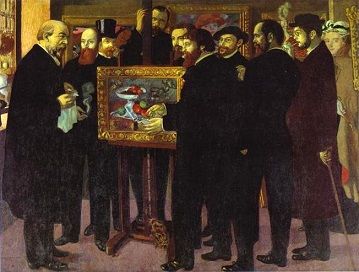
The movement disintegrated as, one by one, its members became more conservative. Vuillard turned to a more naturalistic, conventional style, catering to his upper class patrons, and Bonnard seldom exhibited after 1914. Denis published his collected historical and theoretical work as Nouvelles theories sur l'art moderne, sur l'art sacré (1922) (New Theories of Modern and Sacred Art). In later years, he told his friends that what he had really envisioned was not abstraction, but the tension between flat pattern and the "fullest realization of subject matter." The subjects of his mature works included landscapes and figure studies, particularly of mothers and children. But his primary interest remained the painting of religious subjects, like The Dignity of Labor (1931), commissioned by the International Federation of Christian Trade Unions.
Vuillard, Roussel, and Bonnard later renounced the Nabi doctrines in favor of their own personal styles, while Ranson and Sérusier upheld the Nabi aesthetic. Indeed, Ranson and his wife Marie-France founded the Academie Ranson to extend its influence. Although Ranson died in 1909, Denis and Sérusier taught classes there, and Roussel, Vallotton, and Vuillard attended. There were many students, but none who attained the stature of the original Nabis, with the possible exception of the American artist Maurice Prendergast, who studied in Paris between 1891 and 1895 and was acquainted with both Vuillard and Bonnard. However, in a broader sense, it was Denis's famous and oft-quoted pronouncement that a picture was "essentially a flat surface covered with colors in a particular order" that resonated with countless modern artists on the abstract and non-representational path. In addition, Bonnard's graphic work has exerted its influence on modern advertising design and art students to this day, who study his paintings specifically to learn about color.
 Ask The Art Story AI
Ask The Art Story AI